A Bibliometric Analysis of the Use of Artificial Intelligence Technologies for Social Sciences
Abstract
:1. Introduction
- -
- What is the evolving trend of Big Data and Artificial Intelligence (AI) in the field of (computational) social science? Within social science research, what are the main patterns of topic (keyword) distribution in the field of Big Data and AI?
- -
- Which disciplines and journals are leading and promoting the utilisation of Big Data and AI in social sciences?
- -
- What suggestions can be offered to improve future Big Data research in social sciences?
1.1. Big Data and AI Applications in Social Sciences
1.2. Analysing Big Data and AI Literature with a Bibliometrics Approach
2. Materials and Methods
2.1. Bibliographic Repositories
2.2. Study Design
3. Results
3.1. Social Science Disciplines and Journals
3.2. Computational Social Science: Overarching or Underlying?
4. Discussion
5. Conclusions
Author Contributions
Funding
Institutional Review Board Statement
Informed Consent Statement
Data Availability Statement
Conflicts of Interest
References
- UN Global Pulse. Big Data for Development: Opportunities and Challenges–White Paper. 2012. Available online: https://www.unglobalpulse.org/wp-content/uploads/2012/05/BigDataforDevelopment-UNGlobalPulseMay2012.pdf (accessed on 10 October 2022).
- Mayer-Schönberger, V.; Cukier, K. Big Data: A Revolution That Will Transform How We Live, Work, and Think; Houghton Mifflin Harcourt: Boston, MA, USA, 2013. [Google Scholar]
- Kitchin, R. Big data, new epistemologies and paradigm shifts. Big Data Soc. 2014, 1, 2053951714528481. [Google Scholar] [CrossRef] [Green Version]
- De Neufville, R.; Baum, S.D. Collective action on artificial intelligence: A primer and review. Technol. Soc. 2021, 66, 101649. [Google Scholar] [CrossRef]
- Unver, H.A. Using social media to monitor conflict-related migration: A review of implications for AI Forecasting. Soc. Sci. 2022, 11, 395. [Google Scholar] [CrossRef]
- Cath, C. Governing artificial intelligence: Ethical, legal and technical challenges and opportunities. Philos. Trans. R. Soc. A Math. Phys. Eng. Sci. 2018, 376, 20180080. [Google Scholar] [CrossRef] [PubMed] [Green Version]
- Bircan, T.; Korkmaz, E.E. Big data for whose sake? Governing migration through artificial intelligence. Nat. Humanit. Soc. Sci. Commun. 2021, 8, 241. [Google Scholar] [CrossRef]
- Gefen, A.; Saint-Raymond, L.; Venturini, T. AI for Digital Humanities and Computational Social Sciences. In Reflections on Artificial Intelligence for Humanity; Springer: Cham, Switzerland, 2021; pp. 191–202. [Google Scholar]
- Kong, J.D.; Fevrier, K.; Effoduh, J.O.; Bragazzi, N.L. Artificial Intelligence, Law, and Vulnerabilities. In AI and Society; Chapman and Hall/CRC: London, UK, 2022; pp. 179–196. [Google Scholar]
- Miller, T. Explanation in artificial intelligence: Insights from the social sciences. Artif. Intell. 2019, 267, 1–38. [Google Scholar] [CrossRef]
- Gunning, D.; Stefik, M.; Choi, J.; Miller, T.; Stumpf, S.; Yang, G.Z. XAI—Explainable artificial intelligence. Sci. Robot. 2019, 4, eaay7120. [Google Scholar] [CrossRef] [PubMed] [Green Version]
- Chang, R.M.; Kauffman, R.J.; Kwon, Y. Understanding the paradigm shift to computational social science in the presence of big data. Decis. Support Syst. 2014, 63, 67–80. [Google Scholar] [CrossRef]
- Ligo, A.K.; Rand, K.; Bassett, J.; Galaitsi, S.E.; Trump, B.D.; Jayabalasingham, B.; Linkov, I. Comparing the emergence of technical and social sciences research in artificial intelligence. Front. Comput. Sci. 2021, 3, 653235. [Google Scholar] [CrossRef]
- Veltri, G.A. Big data is not only about data: The two cultures of modelling. Big Data Soc. 2017, 4, 2053951717703997. [Google Scholar] [CrossRef]
- Anastasopoulos, L.J.; Whitford, A.B. Machine learning for public administration research, with application to organizational reputation. J. Public Adm. Res. Theory 2019, 29, 491–510. [Google Scholar] [CrossRef]
- Edelmann, A.; Wolff, T.; Montagne, D.; Bail, C.A. Computational social science and sociology. Annu. Rev. Sociol. 2020, 46, 61–81. [Google Scholar] [CrossRef] [PubMed]
- Schroeder, R. Big data and cumulation in the social sciences. Inf. Commun. Soc. 2020, 23, 1593–1607. [Google Scholar] [CrossRef]
- Xiao, X.Y.; Jin, L.; Kateb, F.; Aldeeb HM, A. Modernisation of urban governance: An approach of ‘Blockchain+ Big Data’. Appl. Math. Nonlinear Sci. 2021, 6, 535–542. [Google Scholar] [CrossRef]
- Li, Y.; Cheng, Q.; Khder, M.A. Nonlinear differential equations in computer-aided modeling of Big Data technology. Appl. Math. Nonlinear Sci. 2022. ahead of print. [Google Scholar] [CrossRef]
- Yang, X.; Liang, X.; Peng, L.; Liu, Y.; Elzefzafy, H. Research on urban landscape big data information processing system based on ordinary differential equations. Appl. Math. Nonlinear Sci. 2022. ahead of print. [Google Scholar] [CrossRef]
- Schroeder, R.; Taylor, L. Big data and Wikipedia research: Social science knowledge across disciplinary divides. Inf. Commun. Soc. 2015, 18, 1039–1056. [Google Scholar] [CrossRef]
- Lazer, D.; Pentland, A.; Adamic, L.; Aral, S.; Barabasi, A.L.; Brewer, D.; Christakis, N.; Contractor, N.; Fowler, J.; Gutmann, M.; et al. Social science. Computational Social Science. Science 2009, 323, 721–723. [Google Scholar]
- Cioffi-Revilla, C. Computation and social science. In Introduction to Computational Social Science; Springer: Cham, Switzerland, 2017; pp. 35–102. [Google Scholar]
- Harford, T. Big data: A big mistake? Significance 2014, 11, 14–19. [Google Scholar] [CrossRef]
- Kitchin, R.; McArdle, G. What makes big data, big data? Exploring the ontological characteristics of 26 datasets. Big Data Soc. 2016, 3, 2053951716631130. [Google Scholar] [CrossRef]
- Laney, D. 3d data management: Controlling data volume, velocity and variety. META Group Res. Note 2001, 6, 1. [Google Scholar]
- Manyika, J.; Chui, M.; Brown, B.; Bughin, J.; Dobbs, R.; Roxburgh, C.; Hung Byers, A. Big Data: The Next Frontier for Innovation, Competition, and Productivity; McKinsey Global Institute: Washington, DC, USA, 2011. [Google Scholar]
- González-Bailón, S. Social science in the era of big data. Policy Internet 2013, 5, 147–160. [Google Scholar] [CrossRef]
- European Commission. The EU Data Protection Reform and Big Data: Factsheet 2016. Available online: http://ec.europa.eu/newsroom/just/document.cfm?docid=41523 (accessed on 10 October 2022).
- Iliadis, A.; Russo, F. Critical data studies: An introduction. Big Data Soc. 2016, 3, 2053951716674238. [Google Scholar] [CrossRef]
- Yu, D.; Xu, Z.; Pedrycz, W.; Wang, W. Information sciences 1968–2016: A retrospective analysis with text mining and bibliometric. Inf. Sci. 2017, 418, 619–634. [Google Scholar] [CrossRef]
- Kwon, S.; Liu, X.; Porter, A.L.; Youtie, J. Research addressing emerging technological ideas has greater scientific impact. Res. Policy 2019, 48, 103834. [Google Scholar] [CrossRef]
- Thelwall, M.; Sud, P. Do new research issues attract more citations? a comparison between 25 scopus subject categories. J. Assoc. Inf. Sci. Technol. 2021, 72, 269–279. [Google Scholar] [CrossRef]
- Niu, J.; Tang, W.; Xu, F.; Zhou, X.; Song, Y. Global research on artificial intelligence from 1990–2014: Spatially-explicit bibliometric analysis. ISPRS Int. J. Geo-Inf. 2016, 5, 66. [Google Scholar] [CrossRef] [Green Version]
- Kalantari, A.; Kamsin, A.; Kamaruddin, H.S.; Ebrahim, N.A.; Gani, A.; Ebrahimi, A.; Shamshirband, S. A bibliometric approach to tracking big data research trends. J. Big Data 2017, 4, 30. [Google Scholar] [CrossRef] [Green Version]
- Raban, D.R.; Gordon, A. The evolution of data science and big data research: A bibliometric analysis. Scientometrics 2020, 122, 1563–1581. [Google Scholar] [CrossRef] [Green Version]
- Peng, Y.; Shi, J.; Fantinato, M.; Chen, J. A study on the author collaboration network in big data. Inf. Syst. Front. 2017, 19, 1329–1342. [Google Scholar] [CrossRef]
- Hu, J.; Zhang, Y. Discovering the interdisciplinary nature of big data research through social network analysis and visualization. Scientometrics 2017, 112, 91–109. [Google Scholar] [CrossRef]
- Liao, H.; Tang, M.; Luo, L.; Li, C.; Chiclana, F.; Zeng, X.-J. A bibliometric analysis and visualization of medical big data research. Sustainability 2018, 10, 166. [Google Scholar] [CrossRef]
- Hu, H.; Wang, D.; Huang, S.Q. International collaboration in the field of artificial intelligence: Global trends and networks at the country and institution levels. In Proceedings of the 17th International Conference on Scientometrics and Informetrics, Rome, Italy, 2–5 September 2019; pp. 2501–2502. [Google Scholar]
- Xu, Z.; Yu, D. A bibliometrics analysis on big data research (2009–2018). J. Data Inf. Manag. 2019, 1, 3–15. [Google Scholar] [CrossRef] [Green Version]
- Alonso, J.M. Teaching explainable artificial intelligence to high school students. Int. J. Comput. Intell. Syst. 2020, 13, 974–987. [Google Scholar] [CrossRef]
- Shukla, A.K.; Janmaijaya, M.; Abraham, A.; Muhuri, P.K. Engineering applications of artificial intelligence: A bibliometric analysis of 30 years (1988–2018). Eng. Appl. Artif. Intell. 2019, 85, 517–532. [Google Scholar] [CrossRef]
- Heradio, R.; Fernandez-Amoros, D.; Cerrada, C.; Cobo, M.J. Group decision-making based on artificial intelligence: A bibliometric analysis. Mathematics 2020, 8, 1566. [Google Scholar] [CrossRef]
- Liang, T.; Liu, Y. Research landscape of business intelligence and big data analytics: A bibliometrics study. Expert Syst. Appl. 2018, 111, 2–10. [Google Scholar] [CrossRef]
- Lafuente-Lechuga, M.; Cifuentes-Faura, J.; Faura-Martínez, U. Sustainability, Big Data and Mathematical Techniques: A Bibliometric Review. Mathematics 2021, 9, 2557. [Google Scholar] [CrossRef]
- Nobre, G.C.; Tavares, E. Scientific literature analysis on big data and internet of things applications on circular economy: A bibliometric study. Scientometrics 2017, 111, 463–492. [Google Scholar] [CrossRef]
- Mishra, D.; Gunasekaran, A.; Papadopoulos, T.; Childe, S.J. Big data and supply chain management: A review and bibliometric analysis. Ann. Oper. Res. 2018, 270, 313–336. [Google Scholar] [CrossRef] [Green Version]
- Hinojo-Lucena, F.-J.; Aznar-Díaz, I.; Cáceres-Reche, M.-P.; Romero-Rodríguez, J.-M. Artificial intelligence in higher education: A bibliometric study on its impact in the scientific literature. Educ. Sci. 2019, 9, 51. [Google Scholar] [CrossRef] [Green Version]
- Marín-Marín, J.-A.; López-Belmonte, J.; Fernández-Campoy, J.-M.; Romero-Rodríguez, J.-M. Big data in education. a bibliometric review. Soc. Sci. 2019, 8, 223. [Google Scholar] [CrossRef]
- Abdulhayoglu, M.A.; Thijs, B. Use of locality sensitive hashing (lsh) algorithm to match Web of Science and Scopus. Scientometrics 2017, 116, 1229–1245. [Google Scholar] [CrossRef]
- Mongeon, P.; Paul-Hus, A. The journal coverage of Web of Science and Scopus: A comparative analysis. Scientometrics 2015, 106, 213–228. [Google Scholar] [CrossRef]
- Raban, D.R.; Gordon, A.; Geifman, D. The information society: The development of a scientific specialty. Inf. Commun. Soc. 2011, 14, 375–399. [Google Scholar] [CrossRef]
- Norris, M.; Oppenheim, C. Comparing alternatives to the web of science for coverage of the social sciences’ literature. J. Informetr. 2007, 1, 161–169. [Google Scholar] [CrossRef]
- Stahlschmidt, S.; Stephen, D. Comparison of Web of Science, Scopus and Dimensions Databases; DZHW: Hannover, Germany, 2020. [Google Scholar]
- Glänzel, W.; Schoepflin, U. A bibliometric study of reference literature in the sciences and social sciences. Inf. Process. Manag. 1999, 35, 31–44. [Google Scholar] [CrossRef]
- Boyack, K.W.; Klavans, R. Co-citation analysis, bibliographic coupling, and direct citation: Which citation approach represents the research front most accurately? J. Am. Soc. Inf. Sci. Technol. 2010, 61, 2389–2404. [Google Scholar] [CrossRef]
- Kessler, M.M. An Experimental Study of Bibliographic Coupling between Technical Papers; Massachusetts Inst of Tech Lexington Lincoln Lab: Lexington, MA, USA, 1962. [Google Scholar]
- Glänzel, W.; Czerwon, H. A new methodological approach to bibliographic coupling and its application to the national, regional and institutional level. Scientometrics 1996, 37, 195–221. [Google Scholar] [CrossRef]
- Rafols, I.; Porter, A.L.; Leydesdorff, L. Science overlay maps: A new tool for research policy and library management. J. Am. Soc. Inf. Sci. Technol. 2010, 61, 1871–1887. [Google Scholar] [CrossRef] [Green Version]
- Bastian, M.; Heymann, S.; Jacomy, M. Gephi: An Open-Source Software for Exploring and Manipulating Networks 2009. Available online: http://www.aaai.org/ocs/index.php/ICWSM/09/paper/view/154 (accessed on 10 October 2022).
- Van Eck, N.J.; Waltman, L. Software survey: Vosviewer, a computer program for bibliometric mapping. Scientometrics 2010, 84, 523–538. [Google Scholar] [CrossRef] [PubMed]
- Petticrew, M.; Roberts, H. Systematic Reviews in the Social Sciences: A Practical Guide; John Wiley & Sons: Hoboken, NJ, USA, 2008. [Google Scholar]
- Alvesson, M.; Gabriel, Y.; Paulsen, R. Return to Meaning: A Social Science with Something to Say; Oxford University Press: Oxford, UK, 2017. [Google Scholar]
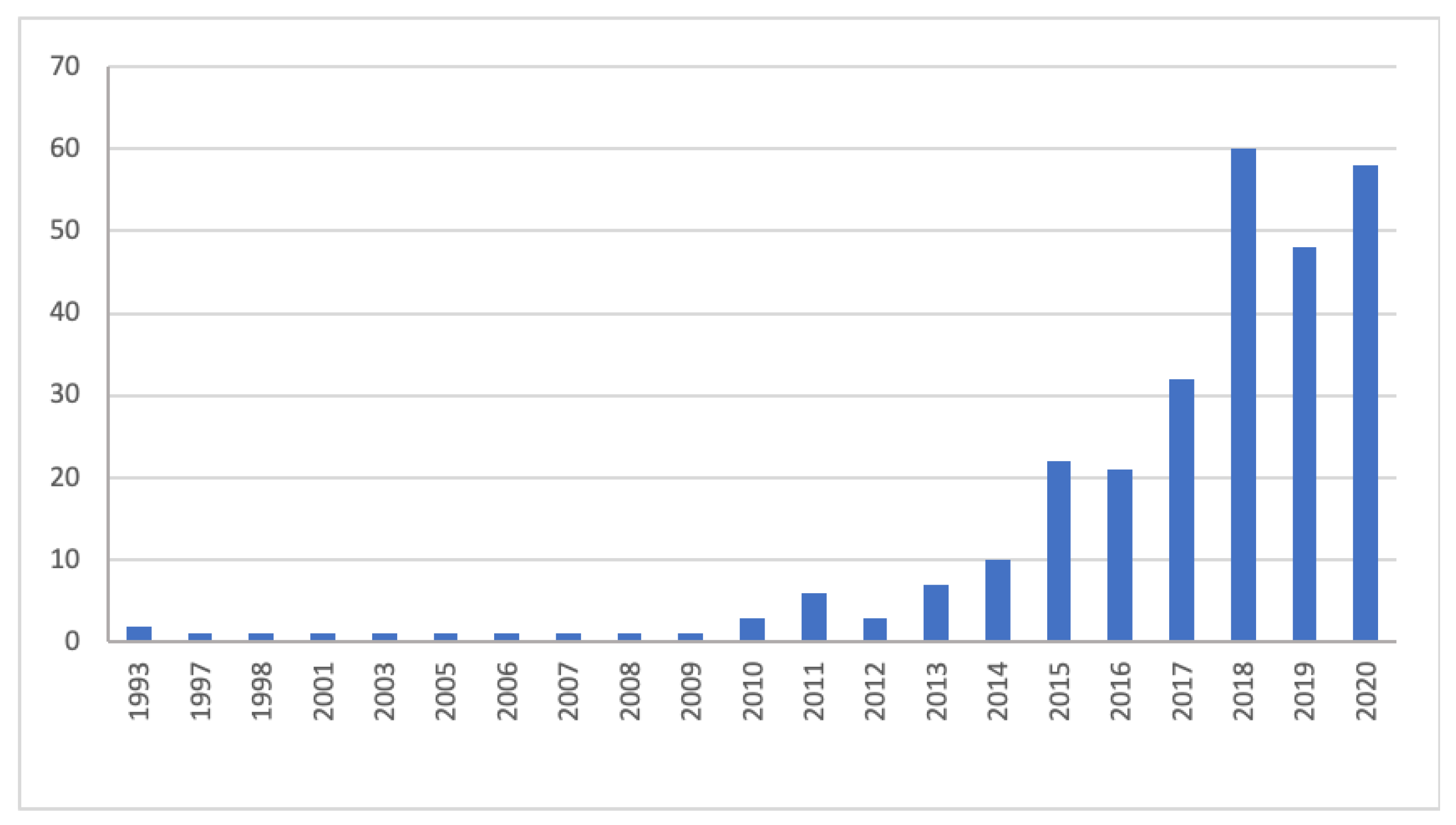


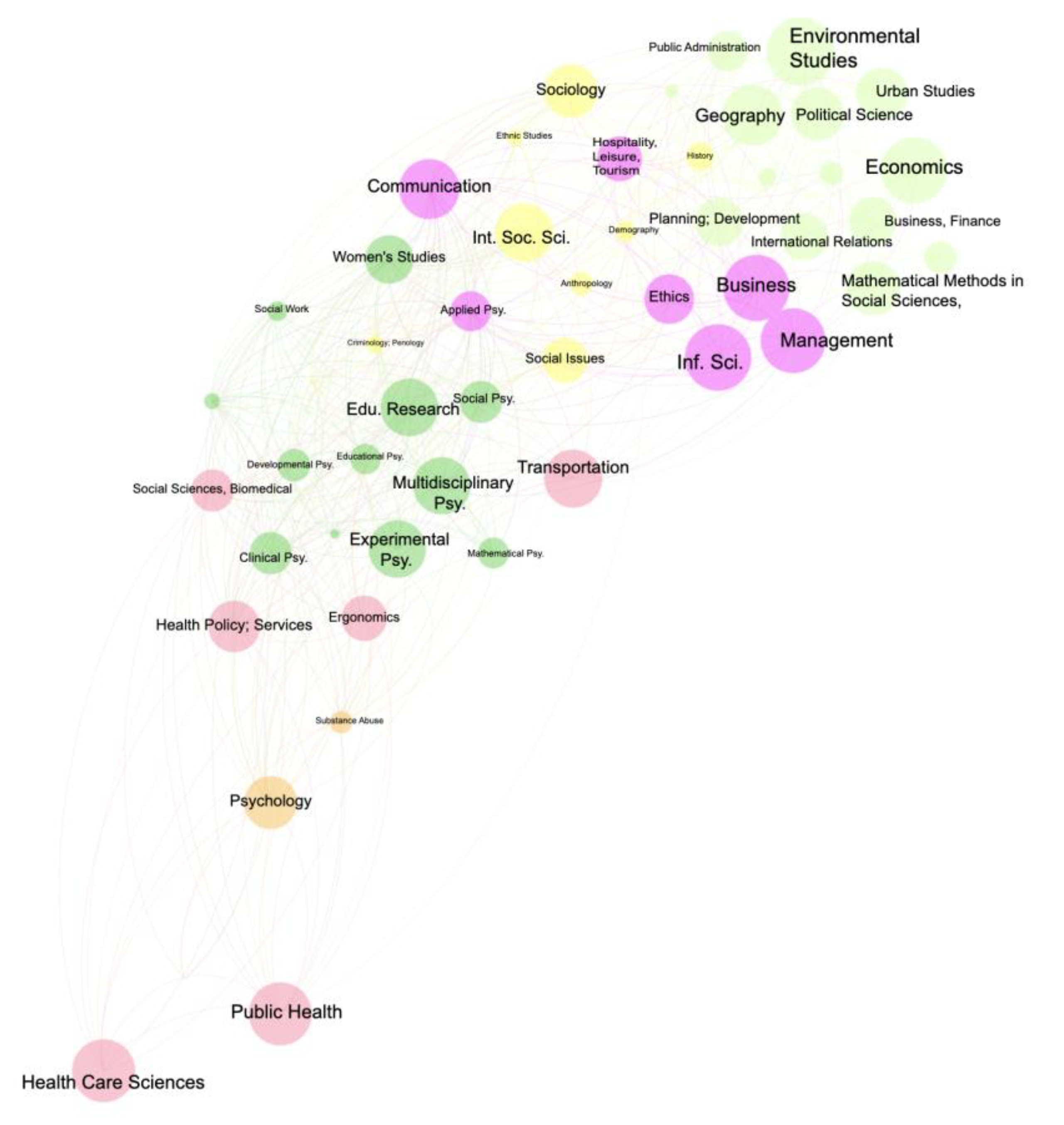
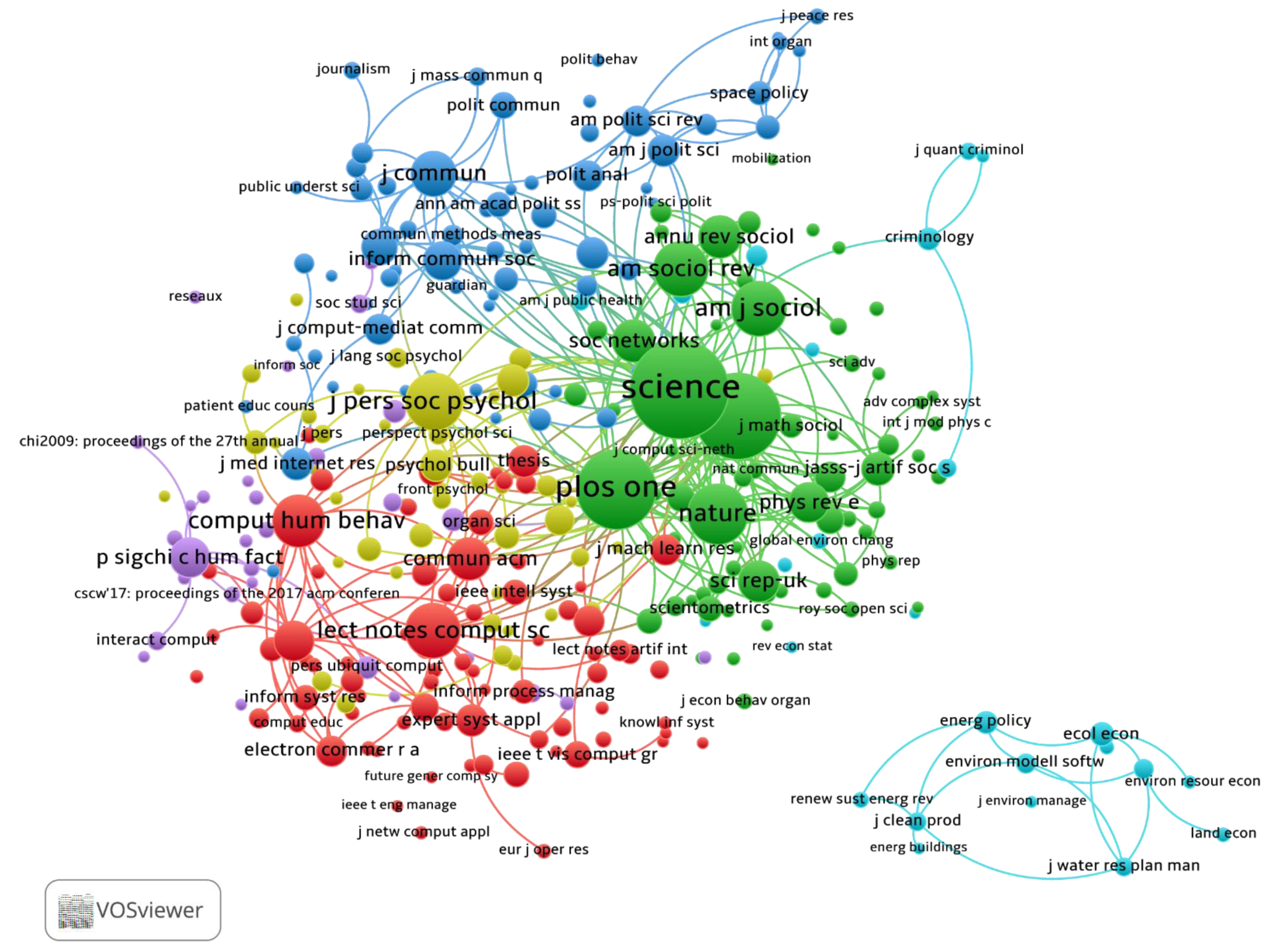

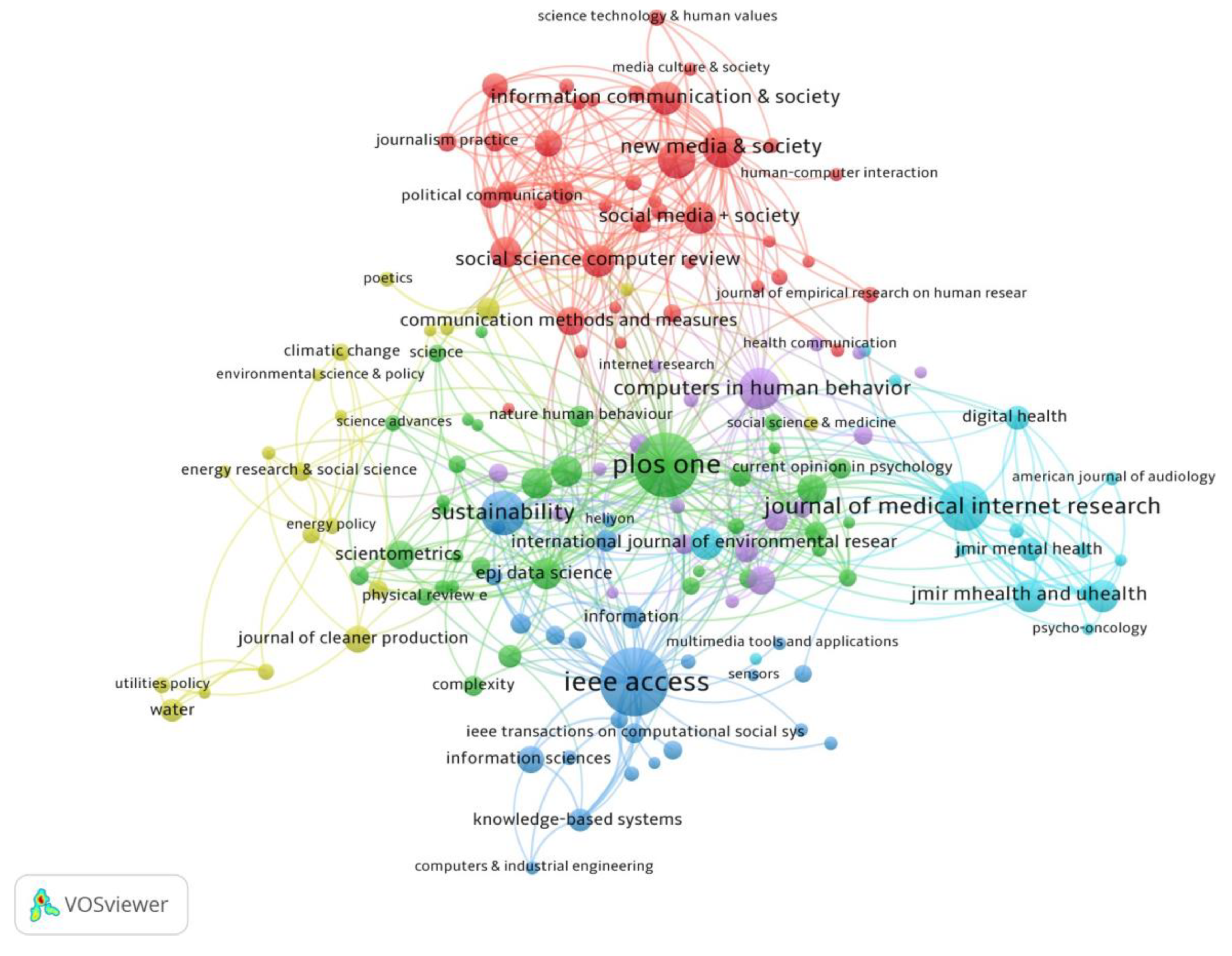


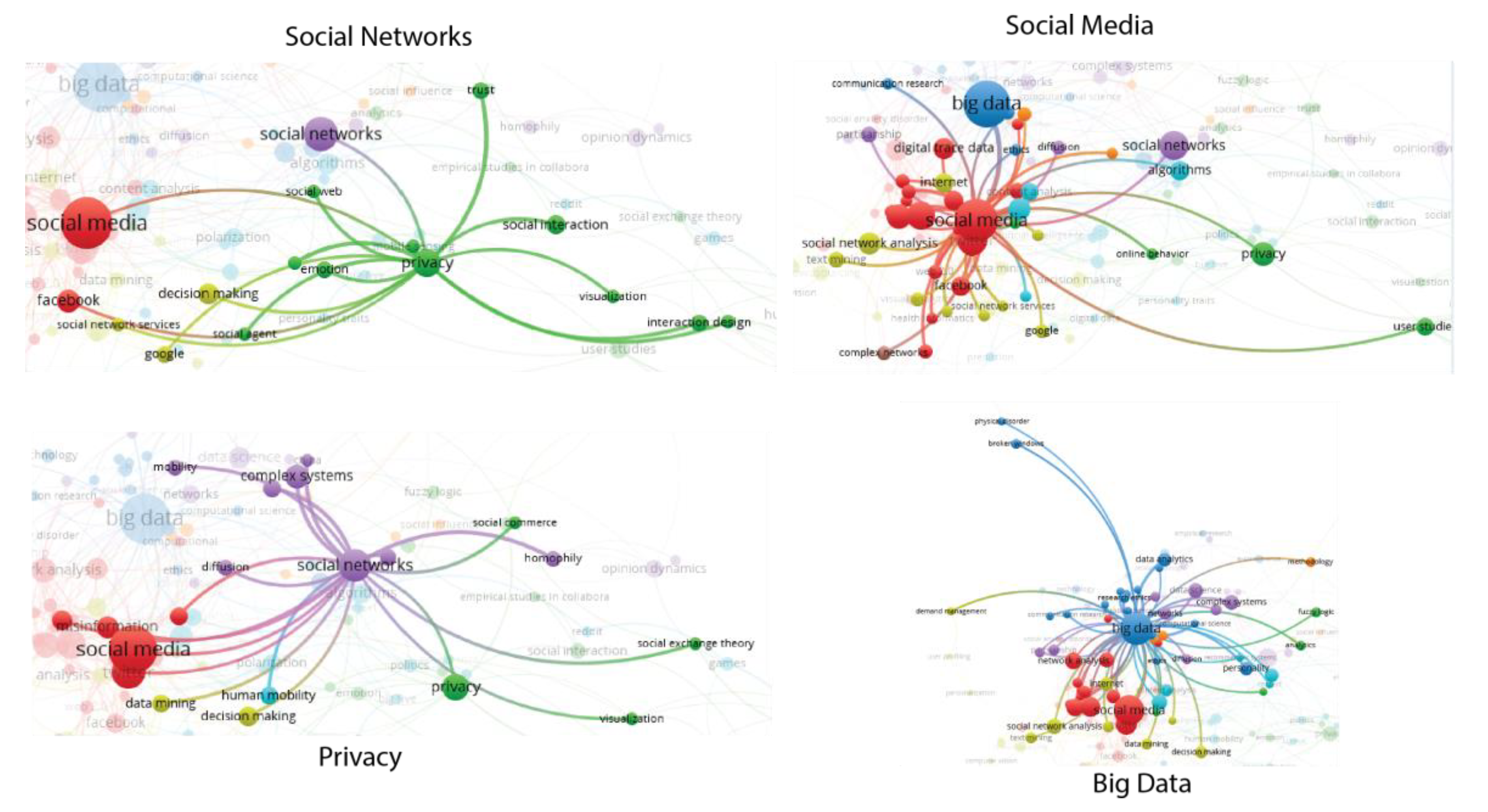
| No of Keywords Out of 5 | No of Articles |
|---|---|
| 1 | 7210 |
| 2 | 1035 |
| 3 | 134 |
| 4 | 6 |
| Grand Total | 8385 |
Publisher’s Note: MDPI stays neutral with regard to jurisdictional claims in published maps and institutional affiliations. |
© 2022 by the authors. Licensee MDPI, Basel, Switzerland. This article is an open access article distributed under the terms and conditions of the Creative Commons Attribution (CC BY) license (https://creativecommons.org/licenses/by/4.0/).
Share and Cite
Bircan, T.; Salah, A.A.A. A Bibliometric Analysis of the Use of Artificial Intelligence Technologies for Social Sciences. Mathematics 2022, 10, 4398. https://doi.org/10.3390/math10234398
Bircan T, Salah AAA. A Bibliometric Analysis of the Use of Artificial Intelligence Technologies for Social Sciences. Mathematics. 2022; 10(23):4398. https://doi.org/10.3390/math10234398
Chicago/Turabian StyleBircan, Tuba, and Almila Alkim Akdag Salah. 2022. "A Bibliometric Analysis of the Use of Artificial Intelligence Technologies for Social Sciences" Mathematics 10, no. 23: 4398. https://doi.org/10.3390/math10234398







